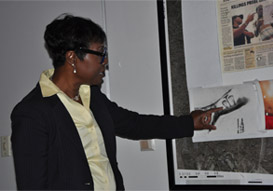“Information is the most valuable tool an investigator has,” said Det. Darcus Shorten. “Investigations are always changing. If we don’t exchange information and share the pros and the cons and the highs and the lows, we won’t have tools that we need. I am hoping these officers take away advanced knowledge through my case studies, and they can use my mistakes or positive aspects to build a better case.”
Using infamous serial killer cases – as well as her own experiences investigating serial crimes and murders in Houston – Det. Shorten discussed the tools and the strategies used to unravel complex cases. Det. Shorten helped solve serial rape cases in Acres Homes (see Texas Monthly). She also discussed such well-known Houston cases as the East Ending killings, where two women and a teenaged girl were murdered, and Coral Eugene Watts, dubbed the Sunday Morning Slasher for killing up to 100 women in Texas, Michigan, and Canada.
Serial killers are defined as those who murder three or more people over a period of more than 30 days. These killers may be driven by anger, the thrill, financial gain, attention, or “pure evil,” Shorten said. Serial killers are classified by category, including those suffering from delusions and hallucinations, those seeking power and control, those on a mission, and those that kill for the thrill and rush. They can be organized, impulsive, or mixed in their approach to murders.
In many cases, serial killers prey on prostitutes because they are easy victims. Many prostitutes lack a family structure, are involved in drug abuse, suffer from mental illness, have a history of sexual abuse or trauma, and are less likely to have a missing person report filed. Prostitutes also are vulnerable because they frequently solicit in public places and then go to a car or a secluded area to perform sexual acts. They also are susceptible to physical or sexual assaults.
It also is vital to analyze links to find relationships among cases, including people, organizations, transactions, and crimes. Those links may include a common location or area, the type of weapon used, a description of a vehicle, DNA from suspects, or features of or phrases used by a suspect. It is important to organize this information using software programs, or such tools as evidence logs, smart boards, or white boards. Among the evidence captured can be names, case numbers, locations, methods, cause of death, suspects, vehicles, etc.
Det. Shorten also used forensic interviewing with victims, asking for sensory-based details about the suspect and crime scene, such as distinguishing features, smells, tastes or clothing.
Databases also are valuable tools to help link suspects and cases. The Combined DNA Index System (CODIS) database includes DNA profiles from actual crime scenes and can provide potential matches to suspects. In fact, during the Acres Homes serial cases, Det. Shorten carried mini DNA swab kits to test individuals identified as potential suspects in the field. Another database that is used is the FBI’s Violent Crime Apprehension Program (VICAP), which maintains information on homicides and sexual assaults nationwide as well as missing and unidentified persons. It is a valuable tool for linking cases and tracing timelines of when suspects were in the area. The FBI’s Behavioral Analysis Unit also can help develop a profile of the killer or killers, identifying potential details about their physical appearance, lifestyle, and location.Patrol officers also are vital components to help solve serial crime. Officers continually should be provided with sketches to help identify suspects or key features. It is important to reinforce the need to preserve the crime scene and to consider the collection of trace evidence in the field whenever possible to help preserve evidence. That evidence could disappear when the body is transported.
Another crucial element in the investigation of serial cases is the medical examiner’s office. While some cases may appear as undetermined or accidental drug overdose deaths, it is important to look at the entire body for clues. “The whole body is evidence,” Shorten said.
Strategy is also necessary when interviewing a suspect. The interviewing officer should meet the suspect and begin to build a rapport before arriving in the interview room. “Know your case,” said Det. Shorten. “Know your suspect. Stay alert and determined.”
“Crossing the Yellow Line - Serial Killers” is expected to be held in the future. For more information, contact Yvette Shorten at t (936) 294-3851 or email her at wys001@shsu.edu

